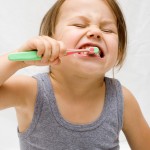
A systematic review has identified 106 potential risk factors to be associated with the prevalence or incidence of dental caries in primary teeth. The aim of this study was to describe the development of new caries over 2 years and to identify risk factors that can predict new caries development.
A random sample of preschool Hong Kong children aged 3–4 years was surveyed and followed up when they reached 5–6 years . Dental caries status was assessed using the dmft index and information on oral health knowledge and behaviour collected from the parents using questionnaires. A negative binomial regression was performed to investigate the factors collected at baseline that could predict the caries increment over 2 years. 358 children attended both examinations.
They found the mean caries increment over 2 years was 0.9. The negative binomial regression showed significantly higher caries increment in children:-
- who used nursing bottles during sleep when they were young (P = 0.013),
- whose toothbrushing began after 12 months (P = 0.005),
- who took snack once or more daily (P < 0.001), and
- whose parents had 9 or fewer years of education attainment (P = 0.002)
They concluded
New caries development of Hong Kong preschool children was low. Children’s feeding, snaking and brushing habits, and parents’ education attainment were the significant predictors for new caries development of preschool children.
Wong MCM, Lu HX,. Lo ECM. Caries increment over 2 years in preschool children: a lifecourse approach. International Journal of Paediatric Dentistry. Article first published online: 19 Jul 2011

Derek:
What was not clear to me here is the clinical vs the statistical impact. For the four identified items, what is their predictive power: 20%, 40%, 60%, 80%?
Rick
Hi Rick
The clinical v statistical significant is a good point. Looking at the data presented for the Incidence rate ratios and 95% confidence intervals. My feeling would be that clinically the first three indicators would be of more clinical significance than the educational attainment, although all are statistically significant.
Snacking more that twice 2.87 (1.70 -4.85)
Not brushing until 2 years of age 2.60 ( 1.50-4.51)
Nursing bottle use 1.58 (1.10-2.26)
More that 14 years education 0.40 (0.24-0.67)
Derek